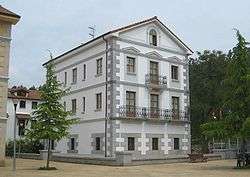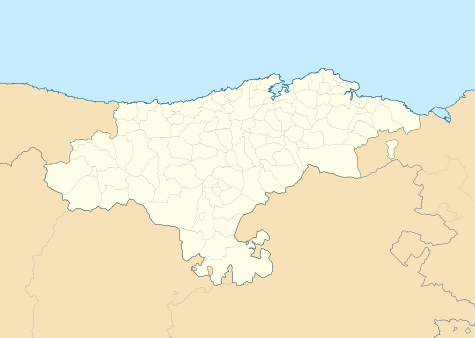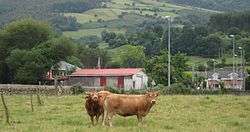Guriezo
Guriezo is a municipality located in the autonomous community of Cantabria, Spain. According to the 2013 census, the town has a population of 2,424 inhabitants. Its capital is El Puente.
Guriezo | |
|---|---|
 Town hall of Guriezo | |
_Mapa.svg.png) Location of Guriezo | |
 Guriezo Location in Spain  Guriezo Guriezo (Spain) | |
| Coordinates: 43°20′31″N 3°19′36″W | |
| Country | |
| Autonomous community | |
| Province | Cantabria |
| Comarca | Asón-Agüera |
| Judicial district | Castro Urdiales |
| Seat | El Puente |
| Government | |
| • Alcalde | Adolfo Izaguirre Ruiz (2011) (PRC) |
| Area | |
| • Total | 74.53 km2 (28.78 sq mi) |
| Elevation | 40 m (130 ft) |
| Population (2018)[1] | |
| • Total | 2,347 |
| • Density | 31/km2 (82/sq mi) |
| Time zone | UTC+1 (CET) |
| • Summer (DST) | UTC+2 (CEST) |
Settlements
- Adino
- Agüera
- Angostina
- Balbacienta
- Cabaña la Sierra.
- Carazón.
- La Corra.
- Francos.
- Landeral.
- Lendagua
- Llaguno
- El Llano
- Lugarejos
- La Magdalena
- Nocina
- Pomar
- El Puente (Seat).
- Ranero
- Revilla
- Rioseco
- Santa Cruz
- Torquiendo
- Trebuesto
- Tresagua
History
Megalithic evidence from the surroundings of Guriezo attests, that the area was inhabited back in prehistorical times as early as 4000 BC.[2] Spear points from the Bronze Age have been found in caves throughout the area, namely in the cave of la Cervajera.[3]
During the Middle Ages, the most prominent dynasties in the area were the Villota and Entrambasaguas families, which fought for the control of administrative and political positions. The conflict between these two families dates back to the 15th century, when they litigated about the ownership of the local foundries. In the second half of the 18th century, their disagreements brought them all the way to the Royal Chancery of Valladolid.[4] Guriezo was quite active in the iron trade with Biscay's foundries during the late Middle Ages.[5] Guriezo played a role in the development of the prosperous Basque iron industry; in 1846, members of the prominent Ybarra family acquired the factory of La Merced, which operated until 1854.[6]
During the Spanish Civil War, Guriezo was the setting for a number of events: on 24 August 1937, the Santoña Agreement was signed in the village, as a result of which 10,000 soldiers from the Basque Army surrendered to Franco's Italian allies.[7] During 1938, a number of republican fugitives under the lead of former lieutenant Manuel Pérez Tejera were ambushed and executed in the mountains around Guriezo; it was not until 1941 when Pérez Tejera himself was found and killed.[8]
Economy

As of 2008, the per capita income of Guriezo stood at €15,010, which was slightly below the regional figure of €15,911, yet Guriezo had one of the greatest per capita incomes among rural Cantabrian municipalities.[9]
In 2007, around 7% of the businesses in Guriezo operated in the agricultural sector, 29% in construction, 13% in industry and roughly 50% in the service sector. When compared to the region as a whole, Guriezo has a considerably lower proportion of service businesses, but a higher percentage of agricultural, building and industrial companies.[10]
When it comes to the labour market, the Eastern Coastal area of Cantabria, which encompasses Guriezo and other municipalities, had an unemployment rate slightly above 20%, in tune with the regional average for 2013.[11] As of April 2014, there were 193 jobseekers in the village.[12]
Demographics
These are the places of birth of the population of Guriezo according to the National Institute of Statistics (INE).
| Total Population | Born in Cantabria | Born in another Autonomous Community | Born in another Country |
|---|---|---|---|
| 2424 | 1215 | 1053 | 156 |
Just over half of the population was born in Cantabria, but a significant percentage of the inhabitants (43.5%) hails from other Autonomous Communities. Just above 6% of the population are immigrants.
Administration
The results of the 2011 local elections were as follows:[13]
| 2011 Spanish local elections | |||||
| Party | Votes | % | Councillors | ||
| PRC | 702 | 46,09 % | 6 | ||
| PP | 571 | 37,49 % | 4 | ||
| PSOE | 139 | 9,13 % | 1 | ||
- Elected Mayor: Adolfo Izaguirre Ruiz (PRC).
References
- Municipal Register of Spain 2018. National Statistics Institute.
- Llama Zubieta, Pilar (2014). "PREHISTORIA". Ayuntamiento de Guriezo. Archived from the original on 2014-05-23. Retrieved 2014-05-25.
- Peralta Labrador, Eduardo (2003). Los cántabros antes de Roma. Real Academia de la Historia. ISBN 84-89512-59-0. Retrieved 2014-05-23.
- Ceballos Cuerno, Carmen (1991). "Balance Económico-Social de la Emigración a Indias en el Valle de Guriezo (Cantabria) en el Antiguo Régimen" (PDF). 1 Reunión Científica de la Asociación Española de Historia Moderna. tabapress/Grupo Tabacalera: 89–95. Retrieved 2014-06-06.
- Arizaga, Beatriz; Bochaca, Michel (2003). "El comercio marítimo de los puertos del País Vasco en el Golfo de Vizcaya a finales de la Edad Media" (PDF). Revista de Estudios Marítimos del País Vasco. Gipuzkoako Foru Aldundia (4): 41–53. Retrieved 2014-05-26.
- Díaz Morlán, Pablo (1999). Los Ybarra vizcaínos: Origen y Expansión de una Dinastía Empresarial (1801-1890) (PDF) (Thesis). Universidad de Alicante. Retrieved 2014-06-02.
- Álvarez Bolado, Alfonso (1995). Para ganar la guerra, para ganar la paz: Iglesia y guerra civil: 1936-1939. Universidad Pontificia de Comillas. ISBN 84-87840-79-5. Retrieved 2014-05-26.
- Gutiérrez Flores, Jesús (2006). Guerra civil en Cantabria y pueblos de Castilla. LibrosEnRed. p. 327. Retrieved 2014-06-02.
- "Distribución municipal de la renta bruta estimada y per cápita estimada (euros). Serie homogénea 2002-2008". Instituto Cántabro de Estadística. 2011. Retrieved 2014-05-30.
- "Actividad económica local" (PDF). Departamento de Medio Ambiente de Cantabria. 2007. Retrieved 2014-06-02.
- "Tasa de actividad y paro de 16 a 64 años según área pequeña". Instituto Cántabro de Estadística. 2013. Retrieved 2014-06-02.
- "Paro registrado por municipios y sectores". Instituto Cántabro de Estadística. 2014. Archived from the original on 2014-06-05. Retrieved 2014-06-02.
- "Elecciones municipales 2011". El Pais. Retrieved 2014-05-08.
External links
| Wikimedia Commons has media related to Guriezo. |
- Guriezo - Cantabria 102 Municipios
- Valle de Guriezo - History and Art of Guriezo Valley